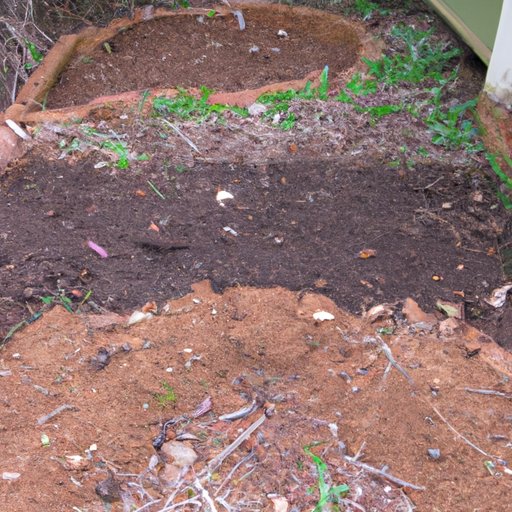Exploring the Basics of Well Drained Soil
Well drained soil is essential for growing a successful garden. But what does well drained soil mean? In this article, we will explore what well drained soil is, what makes it different from other soils and why it’s so important for gardening.
Definition of well drained soil
At its simplest, well drained soil is soil that drains easily. Water should move quickly through the soil, rather than sitting on top or pooling at the bottom. This helps ensure that roots get the oxygen they need to remain healthy and grow.
What makes a soil well drained
Well drained soil has two key characteristics: texture and structure. The texture of the soil refers to the size of the particles that make up the soil. Soils with larger particles are more porous, meaning that water can move more easily through them. The structure of the soil refers to how these particles are arranged. A soil with a good structure allows water to move freely through it, as opposed to clumping together and forming channels.
The importance of well drained soil
Having well drained soil is essential for a successful garden. When soil doesn’t drain properly, water builds up around the roots, which can lead to root rot, nutrient loss, and even plant death. Additionally, poorly drained soil can cause standing water, leading to mosquitoes and other pests. Therefore, it’s important to have well drained soil if you want to create a healthy, vibrant garden.

What to Look for When Identifying Well Drained Soil
When trying to determine if your soil is well drained, there are a few things to look for:
Color and texture
Well drained soil is typically light in color and feels gritty when rubbed between your fingers. If the soil is dark and feels slimy, it may be a sign of poor drainage.
How quickly water drains through the soil
To test how quickly water is draining through the soil, simply dig a hole in the ground. Then fill the hole with water and observe how quickly the water level drops. If it takes more than five minutes for the water to completely drain, then your soil is not well drained.

How to Test Your Soil for Proper Drainage
If you’re still unsure whether or not your soil is well drained, you can conduct a simple test to check the drainage rate. Here’s how:
Digging a hole in the soil
First, dig a hole in the soil about 12 inches deep and 12 inches wide. Then fill the hole with water and let it sit for at least an hour.
Measuring the water level
After an hour, measure the water level in the hole. If the water level has dropped more than 6 inches, then your soil is well drained. However, if the water level has dropped less than 6 inches, then your soil is not well drained.
The Benefits of Well Drained Soil
Having well drained soil offers numerous benefits, including:
Promotes healthy root growth
Well drained soil encourages healthy root growth by allowing air to reach the roots. This ensures that oxygen can circulate around the roots, promoting healthy development.
Prevents standing water
Standing water can attract pests and diseases, so having well drained soil prevents this from happening. It also means that you won’t have to worry about water logging your plants.
Prevents nutrient loss
Poorly drained soil can cause nutrients to leach out of the soil, making it difficult for plants to absorb the necessary nutrients. Having well drained soil prevents this from happening.
Improves air circulation
Well drained soil improves air circulation, which helps promote healthy plant growth. Air circulation also helps keep the soil temperature steady, ensuring that plants don’t become too hot or too cold.

Tips for Improving Poorly Drained Soil
If you have poorly drained soil, there are a few steps you can take to improve it, including:
Adding organic matter
Organic matter such as compost, manure and peat moss can help improve the texture of the soil, making it more porous and allowing water to drain more quickly.
Creating raised beds
Raised beds can help improve drainage by elevating the soil above the surrounding area. This ensures that water flows away from the bed, rather than pooling at the bottom.
Installing drainage systems
In some cases, installing drainage systems such as French drains or rain gardens can help improve drainage in your garden. This is especially useful if you have heavy clay soil.
Common Plants That Thrive in Well Drained Soil
Once you’ve improved the drainage in your garden, you can start planting. Here are some common plants that thrive in well drained soil:
Annuals
Annuals such as petunias, impatiens, and marigolds are great for adding color to your garden. They prefer well drained soil, so make sure to amend your soil accordingly.
Perennials
Perennials such as daisies, daylilies, and hostas are perfect for adding texture and interest to your garden. Most of them prefer well drained soil, so be sure to amend the soil before planting.
Trees and shrubs
Trees and shrubs such as maples, oaks, and rhododendrons can add beauty and shade to your garden. Many of them prefer well drained soil, so be sure to check the soil before planting.
Conclusion
Well drained soil is essential for a successful garden. By understanding what well drained soil is and how to identify it, you can ensure that your plants get the oxygen and nutrients they need to thrive. Additionally, by improving your soil’s drainage, you can prevent standing water, nutrient loss, and root rot. With well drained soil, you can create a healthy, vibrant garden that will last for years to come.
(Note: Is this article not meeting your expectations? Do you have knowledge or insights to share? Unlock new opportunities and expand your reach by joining our authors team. Click Registration to join us and share your expertise with our readers.)
